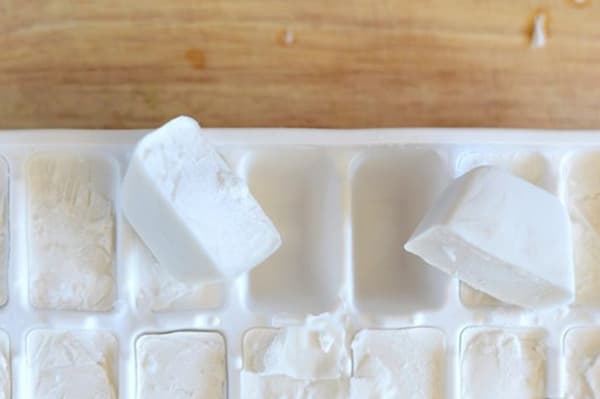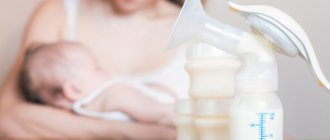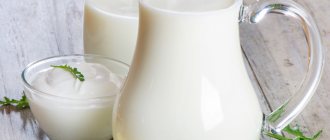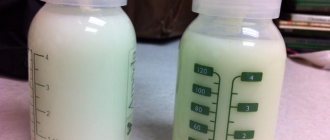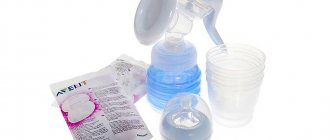When to use freezing
The need for temporary breaks in breastfeeding arises for various reasons. If the mother needs, for example, to go to the doctor, then there is no need for freezing. Pre-expressed milk can simply be placed in the refrigerator and warmed up before feeding.
Breast milk can be stored in the refrigerator for up to a week.
But sometimes there is a need for a much longer break. The reason may be:
- mother’s illness requiring hospitalization, provided the milk is safe for the baby (no infection, no medications harmful to the baby, etc.);
- illness of the baby requiring his isolation;
- baby's refusal to suckle, demand for a bottle;
- long-term departure of the mother (session in another city, business trip of a working mother, etc.).
Often in the initial period of lactation there is an excess of milk. The mammary glands produce more nutrition than the baby needs, and the mother has to express the rest.
If you freeze milk after expressing, it will be very useful after the end of lactation.
How to store breast milk
Freezing is used when it is necessary to preserve valuable baby food for a long time. If we are talking about a short absence of the mother, then you can simply store the prepared food for the baby in a cold place.
How long breast milk can be stored at room temperature, as well as the shelf life of breast milk in other conditions, is indicated in the table.
| Conditions | Temperature | Period |
| No freezing | ||
| In the room | up to 250С | up to 6 hours |
| Cool room | up to 150C | up to 24 hours |
| In a refrigerator | 0-50С | up to 7 days |
| After freezing | ||
| Single chamber refrigerator freezer | below -60C | up to 21 days |
| Freezer of a two-chamber refrigerator | below -150С | up to 6 months |
| Separate freezer | below -180С | up to 12 months |
For long-term storage of food packages, it is better to push them deep into the freezer to avoid the entry of warm air when opening the door.
Freezing breast milk
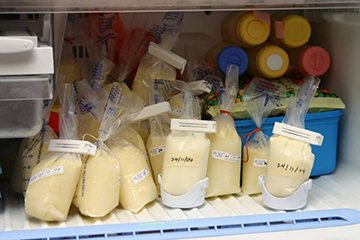
How to express and freeze milk correctly?
Here are the main points to remember:
- Before you start pumping, be sure to wash your hands well and sanitize your breast pump. Breast milk is a sterile liquid, and the fewer microorganisms that are introduced into it during the collection process, the longer it will last.
- Selection of storage containers. You can freeze milk in glass, plastic, plastic containers or use special freezing bags. Reusable containers should be treated with steam or a sterilizer. It is important to pay attention to the tightness of the lid. The most convenient containers are special disposable bags. They provide a number of advantages, since they are initially sterile, do not take up much space in the freezer, and have a scale for determining the volume of expressed milk.
- Make servings of 60-120 ml depending on the age of the child. One serving should not exceed a single dose, so that you do not have to throw out the leftovers after feeding. If the child has not eaten all the food offered to him at one time, it can be offered again within an hour or two, but no more, since bacteria from the baby’s mouth get into the milk and it begins to spoil.
- You can only freeze freshly expressed milk; before freezing it should be placed in the refrigerator for a couple of hours so that it cools gradually and not suddenly. Do not freeze liquids that have already been stored in or out of the refrigerator for more than 1-2 hours.
- Be sure to indicate the date. The shelf life of frozen breast milk at a temperature of -15 degrees is 2 weeks, -18 degrees – up to 6 months, -20 degrees – up to 1 year. When defrosting, follow the “first in, first out” principle. It is important to remember that the indicated storage periods are suitable for milk intended for a healthy baby born at term. Methods and duration of storing milk for babies with health problems or born prematurely should be discussed with a pediatrician.
- The coldest place in the freezer is at the bottom of the back wall. It is best to place the container of milk there.
- It is better to defrost milk gradually - first let it melt in the refrigerator, then heat it to the required temperature with steam, hot water or in a heater.
- Thawed product can be stored in the refrigerator for no more than 24 hours. Re-freezing is not allowed.
Because the composition of breast milk changes over time, it is best to replenish the supply periodically, especially if it is a “just in case” reserve that is not used but intended for an emergency.
Difference between fresh and frozen food
The healthiest thing for a baby is “fresh” milk – straight from the breast. But now we are talking about emergency situations when this method is not available. During the freezing process, milk loses some of its beneficial substances, but, for the most part, its unique properties are preserved.
In any case, breast milk after proper freezing is healthier than any formula.
Visually, thawed milk is no different from freshly expressed breast milk in a bottle. The only possible difference is the smell. A defrosted product may acquire a specific smell that is unusual for a child.
Can breast milk be frozen?
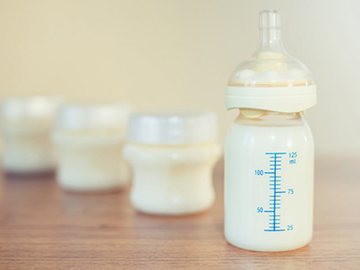
In some situations, the mother knows in advance that in the future there will be a moment when she will not be able to feed the baby herself, but she does not want to stop breastfeeding.
How to store milk to meet your baby's needs?
The longest shelf life is achieved by deep freezing. However, many mothers doubt whether breast milk can be deep-frozen and whether it will retain its beneficial properties after thawing.
Modern science gives an affirmative answer to these questions. In particular, breastfeeding consultants from the international organization La Leche League claim that if storage conditions are observed and the heating process is properly prepared, most of the nutrients are retained in the product.
Research has also found that even thawed breast milk is preferable to formula feeding in most cases.
How to freeze breast milk
When creating a homemade bank of frozen food for a child, you must follow the preparation rules.
Preparation
Strict adherence to hygiene rules is necessary.
Keep your breasts and hands clean, and if you use a breast pump, wash it too. The container for expressing must be thoroughly rinsed and dried; it is not necessary to sterilize it.
Milk collection
Pumping is done after feeding.
During the feeding process, a nursing mother produces oxytocin, which stimulates the flow of breast milk. This makes the pumping process easier.
You can use a breast pump or squeeze manually, whichever is more convenient for a nursing mother.
Freezing containers
You need to decide in advance what to freeze breast milk in. Packages must close tightly and withstand low temperatures well. In practice, glass and plastic containers are used.
Glass containers are convenient to use for storing baby food in liquid form. They are not recommended for freezing for two reasons:
- Glass can burst due to hypothermia and the resulting change in liquid volume.
- During the freezing-thawing process, valuable milk fats stick to the glass walls, depleting the composition of the milk.
Plastic containers made from safe materials do not have these disadvantages. You can use household food-grade plastic containers. Special glasses are produced, small in volume, with measuring divisions, equipped with a sealed lid.
Sometimes you can come across advice to use regular food bags. But this is not the best option - they are fragile, absorb odors, and are inconvenient to fill.
Industrial bags
Experienced mothers recommend industrial bags for freezing breast milk. Their advantages:
- sterility;
- strength;
- sealed clasp;
- the ability to remove excess air;
- image of dimensional divisions;
- presence of a label to indicate the date and other data;
- Possibility of attachment to a breast pump;
- Convenient storage of empty bags;
- possibility of compact storage in the freezer;
- low cost.
Packages of the brands “Dr.Brown's” (package volume 180 ml), “Medela Pump&Save TM” (150 ml), “Avent” (180 ml) have proven themselves well.
Freezing rules
A few tips to help preserve the beneficial properties of baby food as much as possible:
- The product is placed in the freezer only after pre-cooling.
- It is convenient to prepare in small volumes, the optimal size is from 60 to 120 ml.
- The storage portion can be collected at 12 o'clock. A tightly closed container of food is placed in the refrigerator, replenished after each feeding and frozen when the desired volume is reached.
- You can top up the previously frozen volume with a new portion. The added food must first be cooled as much as possible so that it does not defrost the contents of the package.
- There is no need to fill the package completely; it should be left about a quarter empty to avoid damage to the package when the milk freezes.
- If possible, air is removed from the container before placing it in the chamber.
- It is strongly recommended to indicate the date of preparation on the packaging.
- Thawed food should not be returned to the freezer. It is allowed to keep it in the refrigerator for several hours - a maximum of a day.
Properly organized collection of breast milk
You can collect milk at any time, but it is advisable not to do this before you need to leave somewhere. The mother is worried about separation and this can provoke a decrease in milk, then it will not be possible to store it for future use. In other cases there are no restrictions. Expressing should be done when the baby has already eaten, the mother is healthy, and containers for freezing are available. How can you freeze breast milk? In baby bottles, food-grade plastic bags, glass containers, without filling them completely so that they do not burst in the freezer after the liquid expands. All containers must be hermetically sealed.
How to defrost breast milk

Thawing food also requires adherence to certain principles:
- The milk is defrosted gradually - transferred from the freezer to the refrigerator shelf overnight, then kept at normal home temperature, and finally in warm (not hot!) water. This will allow you to preserve its beneficial properties to the maximum.
- If it is necessary to speed up the process, the packaging is immediately placed in warm water.
- Do not use a microwave oven for defrosting - intense heating will destroy useful components.
- Before giving to the baby, the milk is heated to body temperature. You can check your temperature by dropping milk on your wrist.
- Do not allow milk to overheat, especially boiling. It is convenient to use a water bath for heating.
Disadvantages of freezing
The method of storing breast milk in the freezer has its disadvantages. Freezing destroys some of the beneficial substances contained in it. In addition, the specific, soap-like smell that appears in defrosted milk can cause the baby to refuse such food.
Milk expressed in compliance with hygiene requirements can stand in the refrigerator for up to 7 days, practically without deteriorating its properties. Therefore, if the product will be used within this period, it is better not to freeze it, but to store it at the far wall of the refrigerator.
But if we are talking about the need for long-term storage - for example, preserving excess milk in the first months of lactation - freezing is the only option to preserve a valuable product for feeding your baby.
Shelf life
- In a household freezer at a temperature of -18°C, milk can be stored for about 10 days without loss of quality and taste. Then the amount of vitamins and other useful substances will begin to decrease, and the taste will deteriorate, but the product will remain usable for 3-4 months. If the temperature is reduced to -25°C, the milk will be safe for human health for 6 months.
- —
- Temperature fluctuations in the freezer significantly reduce the shelf life of frozen foods.
We recommend: Now it won’t go to waste: 7 ways to store garlic in a glass jar all winter
